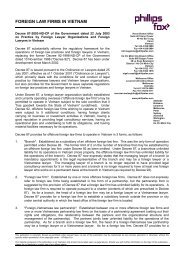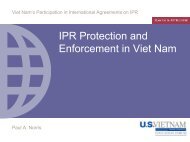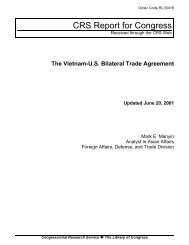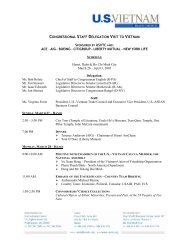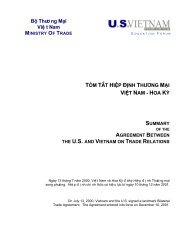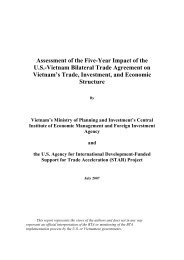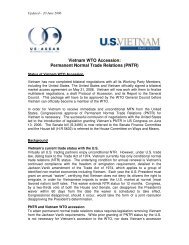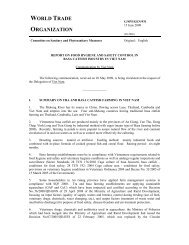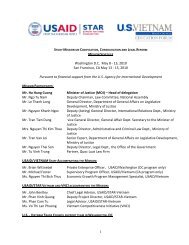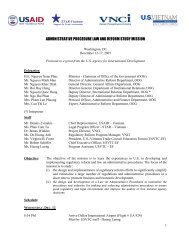Climate risks and adaptation in Asian coastal megacities: A synthesis
Climate risks and adaptation in Asian coastal megacities: A synthesis
Climate risks and adaptation in Asian coastal megacities: A synthesis
- No tags were found...
You also want an ePaper? Increase the reach of your titles
YUMPU automatically turns print PDFs into web optimized ePapers that Google loves.
Table 3.9 ■ Affected Length of Road by Inundation DepthRoad Length by Inundation Depth (kms)8–20 cm 21–50 cm Above 50 cmFlood Scenario (Ex)Major M<strong>in</strong>or Major M<strong>in</strong>or Major M<strong>in</strong>orTotalStatus Quo 4.5 3.9 22.1 23.8 31.9 39.8 125.9B1 5.4 9.7 13.6 15.1 47.9 55.6 147.3A1FI 5.3 6.9 14.6 18.2 53.6 60.3 158.98–20 cmRoad Length by Inundation Depth (kms)21–50 cm Above 50 cmFlood Scenario (BAU)Major M<strong>in</strong>or Major M<strong>in</strong>or Major M<strong>in</strong>orTotalStatus Quo 3.78 4.33 6.40 10.45 7.45 13.42 45.82B1 7.24 8.15 9.54 15.73 12.07 20.82 73.55A1FI 9.45 9.05 12.62 16.28 14.97 25.63 87.99Source: Muto et al. (2010).Impact of exist<strong>in</strong>g flood-related events onthe poor 37In Metro Manila, there is a strong l<strong>in</strong>k betweenwhere the urban poor reside <strong>and</strong> their vulnerabilityto flood<strong>in</strong>g. Interviews with 300 poor households(<strong>in</strong> 14 communities <strong>in</strong> three river bas<strong>in</strong>s) to assessthe impact of floods (conducted as part of theManila study) show that they primarily live <strong>in</strong>environmentally fragile, low-ly<strong>in</strong>g areas <strong>and</strong>/orswamps or wetl<strong>and</strong>s that are highly vulnerable tostorm <strong>and</strong> tidal surges. Households <strong>in</strong>terviewedhave a median monthly <strong>in</strong>come of about 44 pesos/day (less than $1/day). Further, most of them live<strong>in</strong> slum or squatter settlements <strong>and</strong> do not havetenure security or access to basic services such asclean water, electricity, sanitation, <strong>and</strong> dra<strong>in</strong>age.About two-thirds reported suffer<strong>in</strong>g regular lossesdue to typhoons, floods, <strong>and</strong> storm surges. Twentysevenpercent of the households <strong>in</strong>terviewed havesubst<strong>and</strong>ard latr<strong>in</strong>es (dug latr<strong>in</strong>es) or none at all(<strong>and</strong> use neighbor’s latr<strong>in</strong>e or direct to the river/sea). Those who do have toilets compla<strong>in</strong>ed abouttoilets overflow<strong>in</strong>g <strong>and</strong> garbage be<strong>in</strong>g carried dur<strong>in</strong>gfloods contribut<strong>in</strong>g to waterborne diseases.About 65 percent of the households buy water fromneighbors or suppliers. Dur<strong>in</strong>g floods, householdexpenditures on water <strong>and</strong> transportation <strong>in</strong>crease.Cop<strong>in</strong>g strategies <strong>in</strong>clude addition of stilts oradditional levels by households to escape ris<strong>in</strong>gflood waters, use of styrofoam boats, <strong>in</strong>stallationof pumps or “bombastic” to help dra<strong>in</strong> flood water(done <strong>in</strong> some municipalities by the mayor).The survey details many of the public healthhazards associated with flood<strong>in</strong>g . However, for someof the respondents, the consciousness of health <strong>risks</strong>posed by flood<strong>in</strong>g is not very high. They say “H<strong>in</strong>dika naman namamatay dahil sa baha!” (You do notdie from floods or ris<strong>in</strong>g waters here!). For example,the risk of catch<strong>in</strong>g an <strong>in</strong>fection like the deadly effectsof rat’s ur<strong>in</strong>e (i.e., leptospirosis) is not high <strong>in</strong>their consciousness. Follow<strong>in</strong>g Typhoon “Ondoy”<strong>in</strong> September 2009, however, there was an epidemicof leptospirosis that <strong>in</strong>fected over 2,000 people, withover 160 people dy<strong>in</strong>g <strong>and</strong> many requir<strong>in</strong>g dialysis.Estimat<strong>in</strong>g <strong>Climate</strong>-relatedImpacts <strong>in</strong> Ho Chi M<strong>in</strong>h City,VietnamHCMC is a tropical <strong>coastal</strong> city located on theestuary of the Saigon–Dong Nai River system ofVietnam. While not a capital city, Ho Chi M<strong>in</strong>h City37A detailed analysis of the impact of future flood<strong>in</strong>g on thepoor was not undertaken as part of the Manila study <strong>and</strong>needs to be carried out as a follow-up to this report.38 | <strong>Climate</strong> Risks <strong>and</strong> Adaptation <strong>in</strong> <strong>Asian</strong> Coastal Megacities: A Synthesis Report



